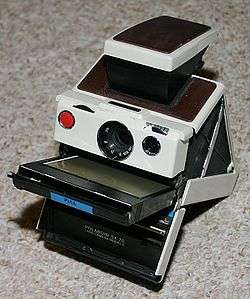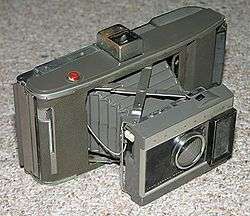Land Camera
Land Cameras are instant cameras with self-developing film named after their inventor, Edwin Land, while working for Research Row in Boston, Massachusetts[1] and manufactured by Polaroid between the years of 1947 and 1983.[2] Though Polaroid continued producing instant cameras after 1983, the name 'Land' was dropped from the camera name since Edwin Land retired in 1982.[3] The first commercially available model was the Polaroid Land Camera Model 95,[4] which produced prints in about 1 minute,[5]and was first sold to the public in November, 1948.[6]
Film
The process, invented by Polaroid founder Edwin Land, was to employ diffusion transfer to move the dyes from the negative to the positive via a reagent. A negative sheet was exposed inside the camera, then lined up with a positive sheet and squeezed through a set of rollers which spread a reagent between the two layers, creating a developing film sandwich. The negative developed quickly, after which some of the unexposed silver halide grains (and the latent image it contained) were solubilized by the reagent and transferred by diffusion from the negative to the positive. After a minute, the back of the camera was opened and the negative peeled away to reveal the print.
In 1963, Land introduced Polacolor pack film, which made instant color photographs possible. This process involved pulling two tabs from the camera, the second which pulled the film sandwich through the rollers to develop out of the camera. The instant colour process is much more complex, involving a negative which contains three layers of emulsion sensitive to blue, green, and red. Underneath each layer are dye developing molecules in their complementary colours of yellow, magenta, and cyan. When light strikes an emulsion layer, it blocks the complementary dye below it. For instance, when blue strikes the blue sensitive emulsion layer, it blocks the yellow dye, but allows the magenta and cyan dyes to transfer to the positive, which combine to create blue. When green and red (yellow) strikes their respective layers, it blocks the complementary dyes of magenta and cyan below them, allowing only yellow dye to transfer to the positive.
In 1972, integral film was introduced which did not require the user to time the development or peel apart the negative from the positive. This process was similar to polacolor film with added timing and receiving layers. The film itself integrates all the layers to expose, develop, and fix the photo into a plastic envelope commonly associated with a Polaroid photo. The Polaroid SX-70 camera was the first to utilize this film.
Improvements in SX-70 film led to the higher speed 600 series film, then to different formats such as 500 series (captiva), and spectra.
Cameras
.jpg)
Rollfilm
The original cameras folded into the body and used bellows to protect the light path. The film was put on two spools, one with the negative roll, and one with the positive paper and reagent pods. The film developed inside the camera. The exception to this is the Polaroid Swinger, a hardbody rollfilm camera whose film was pulled out of the camera body to develop outside the camera. The film for rollfilm cameras was discontinued in 1992.


100 Series Pack cameras
These cameras were developed after the rollfilm models and were designed to use the newly developed 100 series pack film. Like with the Swinger the film sandwich was pulled out of the camera to develop outside of the camera, but instead of two separate rolls the film was built into a compact easy loading film pack which contained 8 exposures. Hard body plastic models were marketed later a low cost alternative to the more expensive models with bellows. There are four generations of folding colorpack cameras the 100, the 200, the 300, and 400 series. Polaroid announced in 2008 the discontinuation of all of its film by 2009, and Fujifilm stopped producing packfilm in 2016. The Impossible-Project currently (2015) manufactures and sells Polaroid integrative type film for 600/SX-70/Spectra Image cameras.
Sample models
Model 95Circa 1940s-50s
|
Model 800Circa 1957-1962
| ||
Model 180
|
SX-701970s
|
Model J66Circa 1961-1963.
| |
See also
References
| Wikimedia Commons has media related to Polaroid cameras. |
External links
- Polaroid Model 95 and Polaroid SX-70 Sonar One Step at Marc's Classic Cameras
- Jims Polaroid Collection








